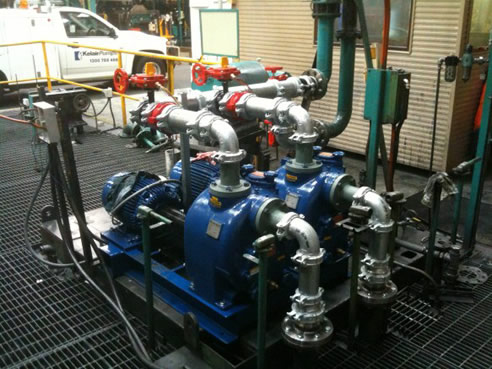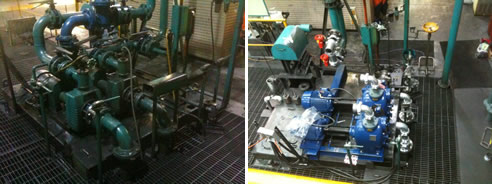NEWS ARTICLE ARCHIVESPioneer Pumps from Kelair Pumps Australia Fig 3 New pumps and pipework
Case Study Pioneer pumps lift capacity A customer of Kelair wanted to improve the throughput capacity of their factory. Part of the works involved the upgrade of an existing dual self-priming pumpset (Fig 1) that supplied cooling water to a metal fabrication line. The existing pumps drew water from a tank mounted in a collection sump and pumped the liquid to a filtration system. The customer wanted to effectively double current flow rates in order to comfortably run all twelve of his machines which could not be done with the existing pumps. Even though these pumps had performed well for the life of the factory to date, they had to be replaced. A Kelair engineer visited the customer's facility and worked through the application with the customer's engineering department. Five potential issues were identified: 1.The water was very dirty, greasy and contained particles of aluminum. 2.There was a 1.5m suction lift. 3.The new pumps had to fit on the existing plinth, which was located on top of a 3.5m tall sheet metal tank installed inside the collection sump.. 4.The new pumps had to be connected to the existing suction and discharge manifolds. 5.The time-frame to remove the existing pumps and install the new pumps was limited. The application was interesting. The pumps had to handle the suction lift, supply the required duty (1,200L/min @ 5m/head) and yet be small enough to fit on the existing plinth and light enough not to buckle the tank walls. Kelair's engineer chose a Pioneer model P3 pump, the smallest pump from Pioneer's self-priming pump range. Pioneer pumps are constructed from durable ductile iron and have a standard SiC-SiC faced mechanical seal, which was important, considering the abrasive metal particles in the pumped liquid. The standard Viton elastomers were chemically suitable for the contaminants in the water. Being a self-priming pump, the 1.5m suction lift posed no problem for the Pioneer P3. Kelair close-coupled the two pumps to 11kW 1,465rpm IP55 electric motors and fitted them to a common baseplate. All fabrication work was conducted at Kelair's Sydney factory. Kelair's engineers took extensive measurements at the site and designed a baseplate and dis-charge manifold to suit the existing location. After consulting with a structural engineer, a length of 150mm RHS was incorporated into the baseplate in order to direct the weight of the pumps down the tank walls and prevent the possibility of the tank's roof buckling under the increased weight (Fig 2).
The new discharge manifold and fittings to connect the new pumps to the existing suction lines were designed to be connected with roll grooved couplings. These were chosen due to the time constraints for installation, as they are easy to prepare on site and are very forgiving of misalignments. A two-man Kelair installation team removed the existing pumps, pre-pared the tank roof for the new baseplate, installed the new pumps and connected the new discharge manifold in 1-1/2 days, well within the time-frame given. The Pioneer pumps and new pipe-work fitted perfectly (Fig 3), and have now been running for eighteen months, allowing Kelair's customer to run the plant at full capacity 24/7. This project involved all departments at Kelair. |
 |
 |
